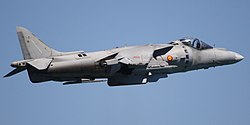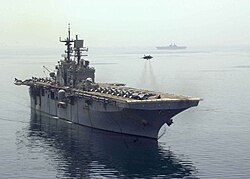McDonnell Douglas AV-8B Harrier II

The McDonnell Douglas (now Boeing) AV-8B Harrier II is a single-engine ground-attack aircraft. It is the second generation of the Harrier Jump Jet family. It is capable of vertical or short takeoff and landing (V/STOL). The aircraft was designed in the late 1970s as an Anglo-American development of the British Hawker Siddeley Harrier, the first operational V/STOL aircraft. It can hover like a helicopter but can also fly like a jet at near supersonic speeds.[1] It is named after a bird of prey of the same name.[2] It is primarily used on light attack or multi-role missions. These range from close air support of ground troops to armed reconnaissance. The AV-8B is used by the United States Marine Corps (USMC), the Spanish Navy, and the Italian Navy. A variant of the AV-8B, the British Aerospace Harrier II, was developed for the British military. Another is the TAV-8B, is a dedicated two-seat trainer.
The project that eventually led to the AV-8B's creation started in the early 1970s. It was a cooperative effort between the United States and United Kingdom (UK). it was aimed at working on solving the problems of the first-generation Harrier. Early efforts centered on a larger, more powerful Pegasus engine to improve the Harrier's performance. The UK dropped out of the project in 1975.[3]
Following the withdrawal of the UK, McDonnell Douglas extensively redesigned the earlier AV-8A Harrier to create the AV-8B. While retaining the general layout of its predecessor, the aircraft uses a new wing, an elevated cockpit, a redesigned fuselage, one extra hardpoint per wing, and other structural and aerodynamic changes. The aircraft is powered by an upgraded version of the Pegasus, which gives the aircraft its V/STOL ability. The AV-8B made its maiden flight in November 1981 and entered service with the USMC in January 1985. Later upgrades added a night-attack capability and radar. This resulted in the AV-8B(NA) and AV-8B Harrier II Plus, respectively. An enlarged version named Harrier III was also studied, but was not built. The UK, through British Aerospace, re-joined the improved Harrier project as a partner in 1981. After corporate mergers in the 1990s, Boeing and BAE Systems have jointly supported the program. Approximately 340 aircraft were produced in a 22-year production program that ended in 2003.
McDonnell Douglas AV-8B Harrier II Media
A USMC AV-8B Harrier II demonstrating its hover capabilities
A Spanish Navy AV-8B Plus in-flight. The nose houses the Hughes APG-65 pulse-Doppler radar.
Marines replacing the one-piece supercritical wing of an AV-8B at Camp Bastion, Afghanistan (2012)
A USMC AV-8B hovers as many more are parked on the deck of amphibious assault ship USS Bataan, one month after the start of the Iraq War
Four AV-8Bs flying in formation over San Diego Bay as part of the Centennial of Naval Aviation celebration in 2011
An Italian Navy AV-8B Plus Harrier II taking off from Italian aircraft carrier Cavour
References
- ↑ "AV-8B HARRIER II". Military Advantage. Retrieved 11 November 2015.
- ↑ Searle, Adrian (29 June 2010). "Fiona Banner's toys for boys are a turn-on at Tate Britain". The Guardian. Archived from the original on 20 October 2013. Retrieved 21 October 2013.
the Harrier is in any case named after a bird of prey.
- ↑ "McDonnell Douglas/British Aerospace AV-8B Harrier II Attack Fighter". Aerospaceweb.org. Retrieved 11 November 2015.







